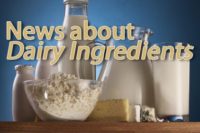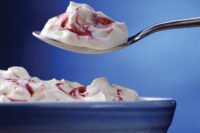Dairy Ingredients Add Nutrition to Snacks
We are a snacking nation. Almost 87% of U.S. consumers snack between meals. In 2009, domestic consumers spent more than $93 billion for foods eaten during a snack occasion. Given the increase in snacking, controversy now rages as to whether snacking abets or abates the obesity crisis in our country.
Snacks, including calorie-laden beverages, now comprise almost 25% of our daily caloric intake according to 2007-2008 NHANES data. At the 2011 IFT annual meeting in New Orleans, Rick Mattes of Purdue University, West Lafayette, Ind., explained that the data is contradictory as to whether snacking is positively or inversely associated with body mass index. Harvey Anderson from the University of Toronto in Canada noted that the composition and resulting physiological effect of between-meals snacks are important. Both Mattes and Anderson agreed that there is no clear definition of a “snack,” and that the lines between meals and snacks are blurred. Anderson and colleagues conclude that increased frequency of eating is not associated with body weight and/or other parameters of obesity, and may in fact be beneficial in this regard.
At the 2010 Dairy Ingredient Symposium in San Francisco, Dan Benardot of the Department of Nutrition at Georgia State University, Atlanta, highlighted several important points on energy balance. “Muscle catabolism (breakdown) does occur with inadequate fuel, as an adaptation to the poor fuel delivery. Infrequent eating and large meals result in higher fat storage, even if total caloric intake is the same. Insulin, blood sugar and leptin (an appetite-suppressing hormone) are best controlled with frequent small feedings that dynamically match energy requirements.”
Nancy Auestad, vice president of regulatory affairs, Dairy Management Inc., Rosemont, Ill., said at the 2011 IFT symposium: “Given the nutrient and caloric contributions of snacks to the American diet, there is a clear opportunity and challenge for food manufacturers to create more nutrient dense snacks.”
When we snack
A study by the Innovation Center for U.S. Dairy found that the world of snacking occasions is almost evenly split between consumers seeking “nutritious” solutions (51%), and those trolling for “fun munching” options (49%).
Looking at retail sales of UPC-coded foods considered to be snack foods reveals that five categories are basic dairy foods - ice cream (3.1% of retail snack dollars), frozen novelties (2.5%), milk (1.3%), yogurt (0.9%) and cheese (0.9%). There are also opportunities to formulate dairy ingredients into several snack categories - candy and gum (7.3%), salty snacks (3.9%), cookies (2.3%), crackers (1.8%) and bars (0.9%.)
The greatest compound annual growth rate from 2004-2009 has been seen in yogurt (5.9%) and salty snacks (5.3%). Adding more naturally nutritious dairy ingredients allows snack manufacturers to play on both the “healthy” and “fun” sides of the snacking occasion.
Dairy ingredients contain a variety of nutrients - including protein, calcium and other dairy minerals - that boost the nutritional content of snacks. Research has shown that diets higher in protein can promote satiety. And while snacks contribute 25% of total energy, they only contribute 14% of daily protein intake. An excellent way to boost the protein content of snacks is by fortifying them with concentrated whey and milk protein ingredients. For those looking for crunchy dairy treats, extruded versions of whey protein concentrate, whey protein hydrolysate and milk protein concentrate are now available. These crisp inclusions are frequently used in nutrition bars such as the new Eat-Smart Chocolate Peanut Caramel Crunch Bars, produced by iSatori, Golden, Colo.
Several companies are now producing freeze-dried yogurt, including Watershed Foods, Gridley, Ill., and Nurture Inc., Devon, Pa., which produces Happy Melts organic freeze-dried yogurt snacks for babies and toddlers. Yogurt powder is also a popular coating for snack items.
Cheese crisps are a crunchy new way for the dairy industry to capture market share in the salty snack category. Kitchen Table Bakers, Syosset, N.Y., won three 2011 Silver Sofi awards from the National Association for the Specialty Food Trade, New York, for crackers made entirely of cheese. Real cheese and cheese powder also add flavor and nutrition to a wide variety of iconic snack crackers, including Pepperidge Farm Cheddar Goldfish (made by Pepperidge Farm Inc., Norwalk, Conn.), Sunshine Cheez-It (manufactured by Kellogg North America Co., Battle Creek, Mich.) and Frito-Lay Cheetos (owned by PepsiCo’s Frito-Lay North America, Dallas).
At the IFT Expo, the U.S. Dairy Export Council featured Cheesy Crunchers, made with reduced-sodium cheese, butter, whey protein concentrate, whey protein crisps, cheese powder and whey permeate. Whey permeate can be added to a wide variety of bakery and snack products to boost flavor and reduce sodium content.
The formula for Cheesy Crunchers and a new monograph on whey permeate for sodium reduction can be found at www.InnovateWithDairy.com. These versatile crunchers are a great example of the power of dairy to create snacks that are fun, tasty and nutrient dense. n
Food industry consultant Sharon Gerdes works with the U.S. Manufacturing & Ingredient Marketing program at the U.S. Dairy Export Council to promote the use of dairy ingredients in food and beverage formulations.
Snacks, including calorie-laden beverages, now comprise almost 25% of our daily caloric intake according to 2007-2008 NHANES data. At the 2011 IFT annual meeting in New Orleans, Rick Mattes of Purdue University, West Lafayette, Ind., explained that the data is contradictory as to whether snacking is positively or inversely associated with body mass index. Harvey Anderson from the University of Toronto in Canada noted that the composition and resulting physiological effect of between-meals snacks are important. Both Mattes and Anderson agreed that there is no clear definition of a “snack,” and that the lines between meals and snacks are blurred. Anderson and colleagues conclude that increased frequency of eating is not associated with body weight and/or other parameters of obesity, and may in fact be beneficial in this regard.
At the 2010 Dairy Ingredient Symposium in San Francisco, Dan Benardot of the Department of Nutrition at Georgia State University, Atlanta, highlighted several important points on energy balance. “Muscle catabolism (breakdown) does occur with inadequate fuel, as an adaptation to the poor fuel delivery. Infrequent eating and large meals result in higher fat storage, even if total caloric intake is the same. Insulin, blood sugar and leptin (an appetite-suppressing hormone) are best controlled with frequent small feedings that dynamically match energy requirements.”
Nancy Auestad, vice president of regulatory affairs, Dairy Management Inc., Rosemont, Ill., said at the 2011 IFT symposium: “Given the nutrient and caloric contributions of snacks to the American diet, there is a clear opportunity and challenge for food manufacturers to create more nutrient dense snacks.”
When we snack
A study by the Innovation Center for U.S. Dairy found that the world of snacking occasions is almost evenly split between consumers seeking “nutritious” solutions (51%), and those trolling for “fun munching” options (49%).
Looking at retail sales of UPC-coded foods considered to be snack foods reveals that five categories are basic dairy foods - ice cream (3.1% of retail snack dollars), frozen novelties (2.5%), milk (1.3%), yogurt (0.9%) and cheese (0.9%). There are also opportunities to formulate dairy ingredients into several snack categories - candy and gum (7.3%), salty snacks (3.9%), cookies (2.3%), crackers (1.8%) and bars (0.9%.)
The greatest compound annual growth rate from 2004-2009 has been seen in yogurt (5.9%) and salty snacks (5.3%). Adding more naturally nutritious dairy ingredients allows snack manufacturers to play on both the “healthy” and “fun” sides of the snacking occasion.
Dairy ingredients contain a variety of nutrients - including protein, calcium and other dairy minerals - that boost the nutritional content of snacks. Research has shown that diets higher in protein can promote satiety. And while snacks contribute 25% of total energy, they only contribute 14% of daily protein intake. An excellent way to boost the protein content of snacks is by fortifying them with concentrated whey and milk protein ingredients. For those looking for crunchy dairy treats, extruded versions of whey protein concentrate, whey protein hydrolysate and milk protein concentrate are now available. These crisp inclusions are frequently used in nutrition bars such as the new Eat-Smart Chocolate Peanut Caramel Crunch Bars, produced by iSatori, Golden, Colo.
Several companies are now producing freeze-dried yogurt, including Watershed Foods, Gridley, Ill., and Nurture Inc., Devon, Pa., which produces Happy Melts organic freeze-dried yogurt snacks for babies and toddlers. Yogurt powder is also a popular coating for snack items.
Cheese crisps are a crunchy new way for the dairy industry to capture market share in the salty snack category. Kitchen Table Bakers, Syosset, N.Y., won three 2011 Silver Sofi awards from the National Association for the Specialty Food Trade, New York, for crackers made entirely of cheese. Real cheese and cheese powder also add flavor and nutrition to a wide variety of iconic snack crackers, including Pepperidge Farm Cheddar Goldfish (made by Pepperidge Farm Inc., Norwalk, Conn.), Sunshine Cheez-It (manufactured by Kellogg North America Co., Battle Creek, Mich.) and Frito-Lay Cheetos (owned by PepsiCo’s Frito-Lay North America, Dallas).
At the IFT Expo, the U.S. Dairy Export Council featured Cheesy Crunchers, made with reduced-sodium cheese, butter, whey protein concentrate, whey protein crisps, cheese powder and whey permeate. Whey permeate can be added to a wide variety of bakery and snack products to boost flavor and reduce sodium content.
The formula for Cheesy Crunchers and a new monograph on whey permeate for sodium reduction can be found at www.InnovateWithDairy.com. These versatile crunchers are a great example of the power of dairy to create snacks that are fun, tasty and nutrient dense. n
Food industry consultant Sharon Gerdes works with the U.S. Manufacturing & Ingredient Marketing program at the U.S. Dairy Export Council to promote the use of dairy ingredients in food and beverage formulations.
Looking for a reprint of this article?
From high-res PDFs to custom plaques, order your copy today!





